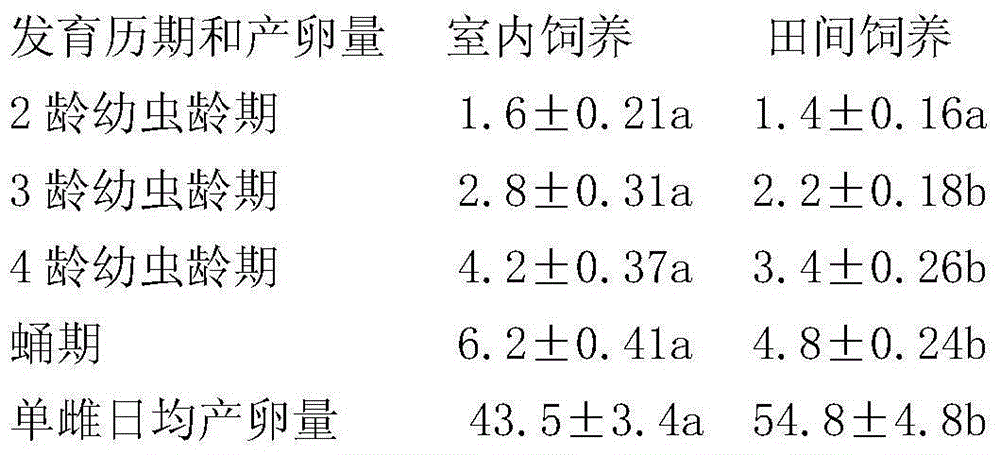Field large-scale propagation method for harmonia axyridis
A heterochromia, field technology, applied in animal husbandry, etc., can solve the problems of human resource consumption, transportation costs, death, lack of adaptability, etc., and achieve the effects of reducing artificial breeding costs, increasing development progress, and increasing adaptability
- Summary
- Abstract
- Description
- Claims
- Application Information
AI Technical Summary
Problems solved by technology
Method used
Image
Examples
Embodiment 1
[0038] The method for a large number of multicolored ladybugs in the field of the present invention is characterized in that it comprises the following steps:
[0039] a. Prepare pea aphids: plant broad beans in the field to form a small rectangle of 3m*3m. When the broad beans grow to 25cm, inoculate pea aphids with a density of 5 heads / plant, and cover the small shed for raising insects at the same time;
[0040] b. Raising egg-laying adults: Putting egg-laying adults and pea aphids into the insect cages with 200 broad bean plants per strain, egg-laying adults lay eggs on the broad bean plants, and cutting the broad bean tenders that are full of pea aphids every day. Tips to supplement fresh pea aphids to provide ample food;
[0041] c. Collect egg masses: Before feeding the egg-laying adults every day, check all the young broad bean leaves and live broad bean leaves that were put in the day before. After finding the egg masses, use scissors to cut the leaves with egg masses...
Embodiment 2
[0048] The method for a large number of multicolored ladybugs in the field of the present invention is characterized in that it comprises the following steps:
[0049] a. Prepare pea aphids: plant broad beans in the field to form a small rectangle of 3m*3m. When the broad beans grow to 35cm, inoculate pea aphids with a density of 5 heads / plant, and cover the small shed for raising insects at the same time;
[0050] b. Raising egg-laying adults: Putting egg-laying adults and pea aphids into the insect cages with 200 broad bean plants per strain, egg-laying adults lay eggs on the broad bean plants, and cutting the broad bean tenders that are full of pea aphids every day. Tips to supplement fresh pea aphids to provide ample food;
[0051]c. Collect egg masses: Before feeding the egg-laying adults every day, check all the tender leaves of broad beans and live broad bean leaves that were put in the day before. After finding the egg masses, use scissors to cut off the leaves with eg...
Embodiment 3
[0058] The method for a large number of multicolored ladybugs in the field of the present invention is characterized in that it comprises the following steps:
[0059] a. Prepare pea aphids: plant broad beans in the field to form a small rectangle of 3m*3m. When the broad beans grow to 30cm, inoculate pea aphids with a density of 5 heads / plant, and cover the small shed for raising insects at the same time;
[0060] b. Raising egg-laying adults: Putting egg-laying adults and pea aphids into the insect cages with 200 broad bean plants per strain, egg-laying adults lay eggs on the broad bean plants, and cutting the broad bean tenders that are full of pea aphids every day. Tips to supplement fresh pea aphids to provide ample food;
[0061] c. Collect egg masses: Before feeding the egg-laying adults every day, check all the tender leaves of broad beans and live broad bean leaves that were put in the day before. After finding the egg masses, use scissors to cut out the leaves with e...
PUM
 Login to View More
Login to View More Abstract
Description
Claims
Application Information
 Login to View More
Login to View More - R&D
- Intellectual Property
- Life Sciences
- Materials
- Tech Scout
- Unparalleled Data Quality
- Higher Quality Content
- 60% Fewer Hallucinations
Browse by: Latest US Patents, China's latest patents, Technical Efficacy Thesaurus, Application Domain, Technology Topic, Popular Technical Reports.
© 2025 PatSnap. All rights reserved.Legal|Privacy policy|Modern Slavery Act Transparency Statement|Sitemap|About US| Contact US: help@patsnap.com

